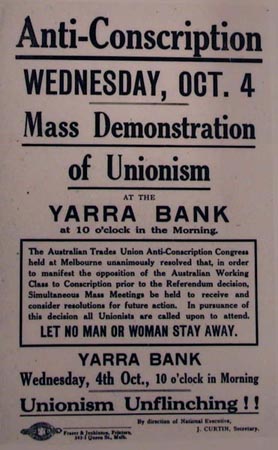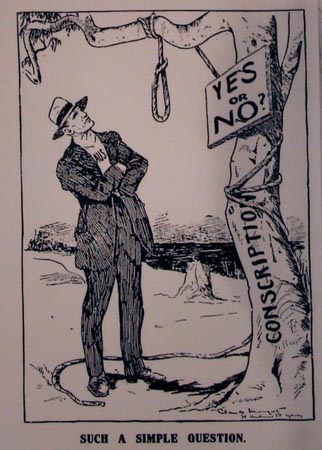One event we’re unlikely to hear much about in the next few years is the 1916 referendum on conscription they held in Australia. Unlike in Britain the people were given a choice as to whether to (re)introduce conscription in Australia.
While much of the propaganda for conscription focused on Australia being invaded by the Germans (!) or the general “cowardice” of those who would not go and fight there was a mass campaign against forcing men to go and fight. Like the anti-war movement in Britain and the rest of Europe this campaign was a mix of radical liberals, working class and socialist organisations as well as religious groups like the Quakers.
 The poster for a mass trade union demonstration against conscription at which a future Labor PM spoke.
The poster for a mass trade union demonstration against conscription at which a future Labor PM spoke.
While this poster shows that many in the Labor Party opposed conscription, it was actually a Labor Prime minister who was pushing for it (and had introduced a form of conscription for boys prior to the war). Many on the left saw their support for conscription as the death of the Labor Party and indeed it led to a split in the party and the formation of a ‘National Labor Party’ after the referendum, which soon merged with others on the right to form the Nationalist Party.
This rally had 30,000 people at it and was followed the next week by another rally of 25,000. An extraordinary show of strength conducted in the middle of the war.
 Propaganda poster encouraging people to vote against conscription
Propaganda poster encouraging people to vote against conscription
While posters like the one above would have been illegal in Britain the space to campaign against conscription was given free reign due to the referendum.
Some argued that while the war was right no one should be forced to go against their will. Badges like this one encouraged people to vote against conscription, but to go and fight as ‘free men’. However, from 1916 onwards there was a distinct drop off in those enlisting to fight in a European war.
No conscription, but yes to the war
Boys as young as twelve were already forced to take part in military training, but this did not require them to go and fight. There was already a great hostility to the idea of compelling children to take part in military training which helped feed the movement against conscription.
 The vote on conscription was characterised as the “death ballot”
The vote on conscription was characterised as the “death ballot”
As in Britain the backbone of the pro-war movement was formed by the government and pro-women’s suffrage organisations. One such group issued a poster saying ’Any right—minded woman would rather be a mother or sister of a dead hero than of a living shirker.’
However, there were, of course, many women who were absolutely opposed both to conscription and the war. This poster asks women not to send young men to their deaths and equates a yes vote with having blood on your hands.
 A poem about how a yes vote was as bad as murder.
A poem about how a yes vote was as bad as murder.
When the result was in Australia had voted against conscription – but only by the tiniest of margins. 1,087,557 voted ‘yes’ and 1,160,033 voted ‘no’.
Outrageously the government would not take no for an answer and began rounding up and jailing key anti-war figures from both the left and religious organisations. Once the organisers of the no campaign were behind bars they held the referendum again, in December 1917.
 Will you vote to be hung?
Will you vote to be hung?
Despite arresting the anti-war leaders the result was almost identical, in fact the margin was slightly wider. The ‘no’ vote was 1,181,747, winning by a slim majority over the ‘yes’ vote was 1,015,159. Conscription was defeated democratically, even in the face of decidedly undemocratic behaviour from those who were in favour of the war.
